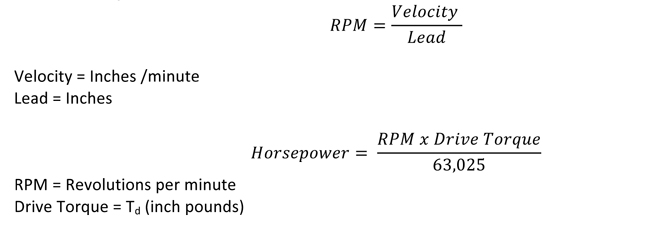A load that is parallel to the centerline of the screw shaft and equally distributed around the mounting surface. It is the recommended method of attaching the load to the nut.
(End Play) The axial free motion between the nut and the screw. It determines the amount of lost motion between the nut and screw on a horizontal application.
There is no formula available to calculate the life of a machine screw. If a calculated life is required, specify a ball screw which has a predictable life based on the life of the ball bearings.
This is the ability of the screw shaft to withstand compressive forces without buckling. The fundamental limit occurs when the compressive load exceeds the elastic stability of the screw shaft, resulting in bending and buckling of the screw. This mode of failure can only occur when the screw shaft is in compression. Joyce/Dayton recommends limiting the maximum compressive load to 80% of the calculated column load strength.
This is a load that tends to compress the screw or buckle the screw shaft. Consideration must be given to column load limitations when screws are used in compression.
This is the theoretical linear velocity (inches/minute) which excites the natural frequency of the screw. As the speed of the screw approaches the natural frequency (critical speed), the screw shaft begins to resonate. This resonance occurs whether the screw or the nut rotates and regardless of the screw orientation. Joyce recommends limiting the maximum linear velocity to 80% of the calculated critical speed value.

Relationship between operation time and rest time. The allowable duty cycle for machine screws is based upon several application variables such as load, speed, and temperature. Consideration must be given to the severity of the duty cycle during the product selection phase. Contact [email protected] for more information.
This is the thrust load which the screw assembly is able to move without exceeding the column strength of the lifting screw.
(Moment Load) This is a load that tends to rotate around the screw imposing a non-axial load on the screw and nut assembly. Eccentric loads reduce the lifr of machine screws; they are not recommended.
This is the ability of a machine screw to convert torque to thrust. Efficiencies that are ≤ 30% tend to be self-locking (in the absence of vibration).
(Bearing mount support configuration) This refers to the method by which the ends of the screws are supported. The end fixity describes the bearing configuration being used to support the rotational axis of the screw. End fixity combinations are determined as a result of critical speed, column loading, and system stiffness calculations. Fixed-Fixed supports provide the greatest support and Fixed-Free supports provide the least support.
The axial distance the screw or nut travels in one revolution.
(Accuracy) The difference between the actual distance traveled and the theoretical distance traveled based on the lead of the screw. Lead error is 005 in./ft. up to 2 ½ inch diameter, and .008 in./ft. up to to 6 inches diameter. Lead error is cumulative based on the actual length of the machine screw thread.
Lubrication is required to achieve optimum operation of machine screw assembly. Apply a NLGI grade #1 grease to the screw thread and nut.
Joyce/Dayton offers full service machining capabilities to supply screw assemblies that are ready for installation. We offer standard end machining that can accommodate our line of bearing blocks as well as custom machining to meet your specific mounting requirements. Screws can also be supplied cut to length with no machining.
(Synchronous Screws) Used when multiple screws are being driven by a single drive in order to keep the screws synchronized. To minimize operational misalignments, lead errors are matched at the factory.
(Root Diameter) The diameter of the screw shaft as measured at the bottom of the thread. This diameter is used in column load and critical speed calculations. Minor diameter is also a consideration in support bearing selection.
The distance from one thread on a screw to a corresponding point on the next thread parallel to the screw axis. Pitch and lead are equal on single start screws.
The number of independent threads on the screw shaft. The lead on the screw is calculated by dividing the threads per inch by the number of starts.
Self-Locking screws require power to move in either direction. They hold position when power to the system is off.
(Radial Load) Load that is applied perpendicular to the screw shaft. This type of load is not recommended for dynamic loads. Static side loads are limited. Contact[email protected] for specific information.
This is the maximum non-operating load capacity.
This is a load that tends to stretch that machine screw. It is the preferred mode of attaching the load because it eliminates column loading as a limiting factor on the screw.
The power to drive a machine screw assembly is a function of the required drive torque and motor R.P.M. Horsepower should be calculated based on the maximum torque required during stroke or cycle. The highest torque requirements generally occur during acceleration, due to inertial loading.

